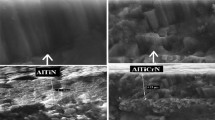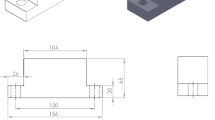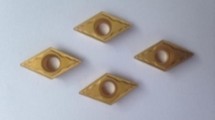Abstract
Mechanical machining inevitably generates undesirable parts on the surface of workpieces. It brings adverse effects in terms of manufacturing cost, surface fineness, malfunction, and lifetime. In order to achieve precise surface with high geometric accuracy, this study proposes a magnetic abrasive cutting (MAC) process to improve surface roughness and make burr-free on the surface of STD-11. All the experiments were conducted by Taguchi’s orthogonal array method with four determined process parameters and three levels. The results analyzed by signal-to-noise (S/N) ratio and analysis of variance (ANOVA) showed that the working gap was the most contribution to the fine surface with 69.9 %, and viscosity of silicone oil affected high geometric precision with 54.1 %. In addition, to satisfy multiple requirements for improving burr removal and surface roughness simultaneously, grey relational analysis (GRA) was employed. From the analysis, the best configuration was at 1.0 mm of the working gap, 600 rpm of spindle speed, 150000 cs of silicone oil, and 1:3 of mixing ratio of abrasive grains and ferromagnetic particles. This study clearly showed that the MAC process assisted by magnetic force was useful to satisfy multi-objective optimization for surface roughness reduction and burr removal.
Similar content being viewed by others
References
F. Hashimoto, H. Yamaguchi, P. Krajnik, K. Wegener, R. Chaudhari, H. W Hoffimeister and F. Kuster, Abrasive fine-finishing technology, CIRP Annals, 65(2) (2016) 597–620.
W. Ding, L. Zhang, Z. Li, T. Zhu, H. Su and J. Xu, Review on grinding-induced residual stresses in metallic materials, The Int. J. of Adv. Manuf. Tech., 88(9–12) (2017) 2939–2968.
A. Y. Jiao, H. J. Quan, Z. Z. Li and Y. H. Zou, Study on improving the trajectory to evaluate the surface quality of plane magnetic abrasive finishing, Int. J. of Manuf. Tech., 80(9–12) (2015) 1613–1623.
R. S. Mulik and P. M. Pandey, Magnetic abrasive finishing of hardened AISI 52100 steel, Int. J. Adv. Manuf. Tech., 55(5–8) (2011) 501–515.
G. C. Verma, P. Kala and P. M Pandy, Experimental investigations into internal magnetic abrasive finishing of pipes, The Int. J. of Adv. Manuf. Tech., 88(5–8) (2017) 1657–1668.
J. Wu, Y. Zou and H. Sugiyama, Study on ultra-precision magnetic abrasive finishing process using low frequency alternating magnetic field, J. of Magnetism and Magnetic Materials, 386 (2015) 50–59.
P. Kala and P. M. Pandey, Comparison of finishing characteristics of two paramagnetic materials using double disc magnetic abrasive finishing, J. of Manuf. Processes, 17 (2015) 63–77.
P. Saraeian, H. S. Mehr, B. Moradi, H. Tavakoli and O. K. Alrahmani, Study of magnetic abrasive finishing for AISI321 stainless steel, Materials and Manuf. Processes., 31(15) (2016) 2023–2029.
A. Misra, P. M. Pandey and U. S. Dixit, Modeling of material removal in ultrasonic assisted magnetic abrasive finishing process, Int. J. of Mech. Sci., 131–132 (2017), 853–867.
A. Misra, P. M. Pandey, U. S. Dixit, A. Roy and V. V. Silver-schmidt, Multi-objective optimization of ultrasonic-assisted magnetic abrasive finishing process, The Int. J. of Adv. Manuf. Tech., 101(5–8) (2019) 1661–1670.
P. Kala and P. M. Pandey, Comparison of finishing characteristics of two paramagnetic materials using double disc magnetic abrasive finishing, J. of Manuf. Processes, 17 (2015) 63–77.
T. Mori, K. Hirota and Y. Kawashima, Clarification of magnetic abrasive finishing mechanism, J. of Materials Processing Tech., 143–144 (2003) 682–686.
S. Wojciechowski, R. W. Maruda, G. M. Krolczyk and P. Niestony, Application of signal to noise ratio and grey relational analysis to minimized forces and vibrations during precise ball end milling, Precision Engineering, 51 (2018) 582–596.
Author information
Authors and Affiliations
Corresponding author
Additional information
This paper was presented at ICMR-2019, Maison Glad Jeju, Jeju, Korea, November 27–29, 2019.
Jung-Hee Lee is a doctoral researcher of the Department of Mechanical Engineering, Pukyong National University, Busan, Korea. Her research interests include micro machining and magnetic abrasive finishing for complex micro patterns.
Jae-Seob Kwak is a Professor of the Department of Mechanical Engineering, Pukyong National University, Busan, Korea. He received his Ph.D. in Mechanical Engineering from Pusan National University. His research interests include micro machining, micro EDM and artificial neural network.
Rights and permissions
About this article
Cite this article
Lee, JH., Kwak, JS. Optimizing multi-requirements of surface finishing in magnetic abrasive cutting process using grey relational analysis. J Mech Sci Technol 34, 4061–4067 (2020). https://doi.org/10.1007/s12206-020-2217-6
Received:
Revised:
Accepted:
Published:
Issue Date:
DOI: https://doi.org/10.1007/s12206-020-2217-6




